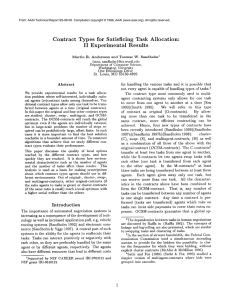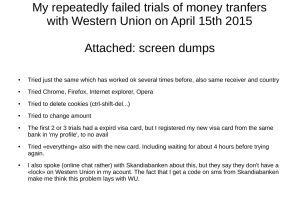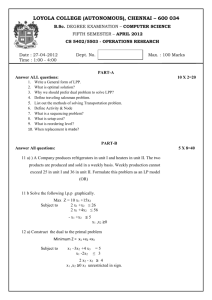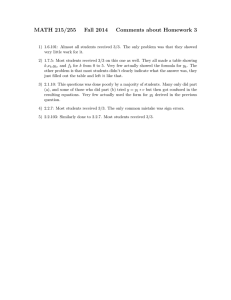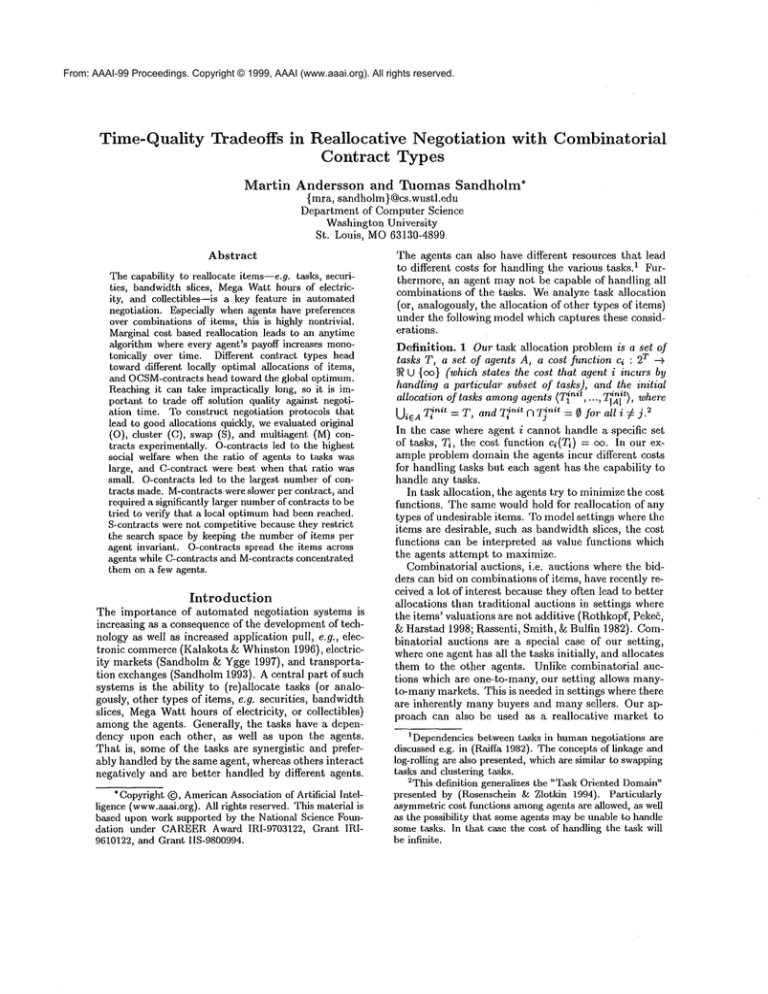
From: AAAI-99 Proceedings. Copyright © 1999, AAAI (www.aaai.org). All rights reserved.
Time-Quality Tradeoffs in Reallocative Negotiation
Contract Types
Martin
with Combinatorial
Andersson
and Tuomas
Sandholm*
{tara, sandholm}@cs.wustl.edu
Department of Computer Science
Washington University
St. Louis, MO63130-4899
Abstract
Thecapability to reallocate items--e.g, tasks, securities, bandwidthslices, MegaWatt hours of electricity, and collectibles--is a key feature in automated
negotiation. Especially whenagents have preferences
over combinationsof items, this is highly nontrivial.
Marginal cost based reallocation leads to an anytime
algorithm where every agent’s payoff increases monotonically over time. Different contract types head
toward different locally optimal allocations of items,
and OCSM-contractshead toward the global optimum.
Reachingit can take impractically long, so it is important to trade off solution quality against negotiation time. To construct negotiation protocols that
lead to goodallocations quickly, we evaluated original
(O), cluster (C), swap (S), and multiagent (M)
tracts experimentally. O-contracts led to the highest
social welfare whenthe ratio of agents to tasks was
large, and C-contract were best whenthat ratio was
small. O-contracts led to the largest numberof contracts made.M-contracts were slower per contract, and
required a significantly larger numberof contracts to be
tried to verify that a local optimumhad been reached.
S-contracts were not competitive because they restrict
the search space by keeping the number of items per
agent invariant. O-contracts spread the items across
agents while C-contracts and M-contracts concentrated
them on a few agents.
Introduction
The importance of automated negotiation systems is
increasing as a consequence of the development of technology as well as increased application pull, e.g., electronic commerce(Kalakota 8z Whinston 1996), electricity markets (Sandholm & Ygge 1997), and transportation exchanges (Sandholm 1993). A central part of such
systems is the ability to (re)allocate tasks (or analogously, other types of items, e.g. securities, bandwidth
slices, MegaWatt hours of electricity, or collectibles)
amongthe agents. Generally, the tasks have a dependency upon each other, as well as upon the agents.
That is, some of the tasks are synergistic and preferably handled by the same agent, whereas others interact
negatively and are better handled by different agents.
* Copyright©, AmericanAssociation of Artificial Intelligence (www.aaai.org).All rights reserved. This material
based upon work supported by the National Science Foundation under CAREER
Award IRI-9703122, Grant IRI9610122,and Grant IIS-9800994.
The agents can also have different resources that lead
to different costs for handling the various tasks. 1 Furthermore, an agent may not be capable of handling all
combinations of the tasks. Weanalyze task allocation
(or, analogously, the allocation of other types of items)
under the following model which captures these considerations.
Definition. 1 Our task allocation problem is a set of
tasks T, a set of agents A, a cost function ci : 2T --+
U {oo} (which states the cost that agent i incurs by
handling a particular subset of tasks), and the initial
allocation of tasks amongagents (T~nit .... , T~l~t), where
Ui~A
T[""= T, andT[""n Tj""= 0 for all i # j2
In the case where agent i cannot handle a specific set
of tasks, Ti, the cost function ci(Ti) = oo. In our example problem domain the agents incur different costs
for handling tasks but each agent has the capability to
handle any tasks.
In task allocation, the agents try to minimizethe cost
functions. The same would hold for reallocation of any
types of undesirable items. 2"o model settings where the
items are desirable, such as bandwidth slices, the cost
functions can be interpreted as value functions which
the agents attempt to maximize.
Combinatorial auctions, i.e. auctions where the bidders can bid on combinations of items, have recently received a lot of interest because they often lead to better
allocations than traditional auctions in settings where
the items’ valuations are not additive (Rothkopf, Pekea,
& Harstad 1998; Rassenti, Smith, 8¢ Bulfin 1982). Combinatorial auctions are a special case of our setting,
where one agent has all the tasks initially, and allocates
them to the other agents. Unlike combinatorial auctions which are one-to-many, our setting allows manyto-many markets. This is needed in settings where there
are inherently manybuyers and many sellers. Our approach can also be used as a reallocative
market to
1Dependenciesbetween tasks in humannegotiations are
discussed e.g. in (Ralffa 1982). The concepts of linkage and
log-rolling are also presented, whichare similar to swapping
tasks and clustering tasks.
eThis definition generalizes the "Task Oriented Domain"
presented by (Rosenschein &~Zlotkin 1994). Particularly
asymmetriccost functions amongagents are allowed, as well
as the possibility that someagents maybe unable to handle
sometasks. In that case the cost of handling the task will
be infinite.
correct inefficient allocations after some one-to-many
auction has been held. In other words, someof the bidders may not have received the (combinations of) items
that they want, and may have received (combinations
of) items that they do not want. The bidders can then
participate in our reallocative many-to-manyaftermarket to improvethe overall allocation of items.
The agents can change the task allocation by reallocating tasks among themselves by contracting. The
agents can also recontract out tasks that they contracted in earlier.
We study agents that are selfinterested and myopically individually rational. This
meansthat an agent agrees to a contract if and only if
the contract increases the agent’s immediate payoff. An
agent’s payoff consists of the payments received from
others for handling their tasks minus the current value
of the cost function, ci, minus payments sent to others
for them to handle some of the former agent’s tasks.
This paper experimentally studies task reallocation
among such agents using combinatorial contract types
that were recently introduced (Sandholm 1993; 1996;
1998) to be used in contract nets (Smith 1980).
next section presents the application domainof the experiments. The different contract types and their use is
described in the following section. Then evaluation criteria are discussed and the results are presented. The
final section concludes the paper.
Example
problem:
Multiagent
TSP
Westudy contracting in a particular task allocation
problem, the multiagent Traveling Salesman Problem
(TSP). This domain is used as an example because it is
structurally simple--providing repeatability and easy
presentability--yet it captures the essence of the difficulties in reallocative negotiation. The TSP is NPcomplete and the space of task allocations contains
manylocal optima when using hill-climbing-based contracting algorithms (Sandholm 1993; 1998).
The multiagent TSP is defined as follows (Andersson
~c Sandholm1998a; 1998b). Several salesmen are going
to visit several cities in a world that consists of a unit
square, see Figure 1. Each city must be visited by exactly one salesman, and each salesman must return to
his starting location after visiting the cities assigned to
him. A salesman can visit the cities assigned to him in
any order. The locations of the cities and the starting
points of the salesmen are randomly chosen as is each
salesman’s initial assignmentof cities to visit.
Agents’ objectives
Fromthis initial assignment, the salesmen can exchange
cities, i.e. tasks, with each other. Each salesman, i.e.
agent, tries to maximize his immediate payoff. The
payoff of salesman i consists of the payments received
from others for handling their cities, minushis distance
traveled, ci, minus payments sent to others for them to
handle someof the former agent’s cities.
The cost of travel between any two locations,
q and r, is the Euclidean distance:
Cqr ~-
Figure 1: An example problem instance of a multiagcnt
TSPconsisting of five cities (~) and two salesmen(X).
salesman A contracts out city 1 to salesman B, the social
welfarewill increase dueto less travel, i.e., lower costs.
J(Xq -- xr) 2 + (yq -- y~)2. The cost that salesman i incurs whenvisiting his cities is the sumof the costs along
his tour:
Ci ~
~
q,rE tour of salesman
Cqr
i
Solution quality, social welfare, is the sumof the distances traveled by the salesmen:
Ial
Social welfare = -- ~ ci
i=1
The side payments do not affect social welfare because
they just redistribute wealth among the agents. Since
the salesmen are individually rational in giving and taking tasks and side payments, each agent’s payoff improves monotonically during the negotiation. It follows
that social welfare improves monotonically.
In our experiments the negotiation occurs before the
salesmen are dispatched. The contracting scheme can
also directly be used in dynamic settings where new
tasks arrive and are handled during the negotiation.
Each new domain event simply changes the cost function, ci, of the corresponding agent.
Summary of contract
types
The contracts most commonly used in multiagent contracting
systems only allow for one task to move
from one agent to another at a time (Smith 1980;
Sen 1993). Wewill refer to this type as an original
((9) contract. In settings where an agent’s cost (or even
feasibility)
of handling a task depends on what other
tasks the agent has, O-contracts often reach local optimawhere no agreeable contract exists--i.e,
a contract
that improves social welfare so that it could be made
profitable for both parties using a side payment--but a
globally optimal allocation has not been reached (Sandholm 1998). To address this problem, new types of
contracts were recently introduced (Sandholm 1993;
Sandholm & Lesser 1995; Sandholm 1996; 1998): cluster (C), swap (S), and multiagent (M) contracts, as well
as all the above, including the original contracts, combined (OCSM-contracts). These new contract types allow more than one task to be transferred between the
agents participating in the contract. C-contracts transfer two or more tasks from one agent to another. Scontracts let two agents swap tasks with each other:
one task is transferred from each agent to the other.
M-contracts allow atomic transfers of tasks amongmore
than two agents. Wenow present these contract types
in more detail.
Original
contracts
(O-contracts)
The most commoncontracts used in contract net implementations and analysis of contracting games are ones
in which one task is transferred from one agent to another. A side payment can also be transferred between
the agents to compensate the party that is worse off
after the transfer of the tasks, i.e., the agent taking on
the task will be paid to do so. Due to this, any social
welfare improving contract can be made beneficial to
both parties. Formally:
Definition. 2 An O-contract is a pair (Ti,j,Pi,j)
,
where ITi,jl = 1. ~,j is the task set (including one
task) that agent i gives to agent j, and Pid is the contract price that i pays to j for handling the task set.
If the agents carried out a full lookahead, i.e., completely searched the tree of all possible future contracts,
O-contracts would suffice to reach the globally optimal
task allocation (Sandholm 1998). However, this generally cannot be accomplished, except for small problem
instances, due to the complexity of searching the tree.
The global optimum is not necessarily reached if the
agents are myopically individually rational when contracting. Such agents may get stuck in a local optimum
since they will not accept a temporary decrease of payoff, which may be necessary to reach the global optimum.Individually rational contracting can be seen as
hill-climbing in the task allocation space, where there
is a risk of being trapped in a local optimuminstead of
reaching the globally optimal task allocation.
Cluster
contracts
(C-contracts)
Cluster contracts allow the agents to exchange more
than one task in each contract, together with a side
payment (Sandholm 1993; 1998):
Definition. 3 (Sandholm 1997; 1998) cl uster co ntract (C-contract) is a pair (Tid, PiS), where [Tidl > 1.
Tid is the task set that agent i gives to agent j, and Pid
is the contract price that i pays to j /or handling the
task set.
Swap contracts
(S-contracts)
Even when both O-contracts and C-contracts are used,
local optima exist. For example,even if there is no profitable O- or C-contract, there may be beneficial swaps
of tasks to be made between two agents. In a swap
contract (Sandholm 1998), one agent gives a task
another agent and receives another task from the latter
agent. A side payment may also be paid between the
agents to compensate for any value difference between
the tasks. Formally:
Definition.
4 (Sandholm 199~’; 1998) swap co n-
tract(S-contract)
is 4-tuple (~
,~, T~
,~, p~
,~, pj,~>, wh
ere
IT~,jl-- ITs,~I--
1. T/5 is the task set (including one
task) that agent i gives to agent j. Tj,i is the task set
(including one task) that agent j gives to agent i. Pi5
is the amount that i pays to j, and Pj,i is the amount
that j pays to i.
Multiagent
contracts
(M-contracts)
Even when all three of the contracts described above
(O, C, and S) are used, the global optimum may still
not be reached if the agents are myopically individually rational when contracting. To avoid some of the
remaining local optima, M-contracts were introduced
3(Sandholm 1998):
Definition.
5 (Sandholm 1997; 1998) multiagent
contract (M-contract) is a pair (T, p) of ]A] × IAI matrices, where at least three elements oft are non-empty
(otherwise this would be just a 2-agent contract), and
for all i and j, ITLjl ~ 1. An element Ti,j is the set of
tasks that agent i gives to agent j, and an element pi,j
is the amountthat i pays to j.
OCSM-contracts
OCSM-contracts are defined as contracts that merge
the characteristic of all the contract types discussed so
far. That is, any number of tasks can be transferred
from and to any agent or between many agents in one
single contract:
Definition.
6 An OCSM-contract is a pair (T, p)
]A] x I A] matrices. An element Ti,j is the set of tasks
that agent i gives to agent j, and an element Pi,j is the
amountthat i pays to j.
OCSM-contracts are necessary and sufficient
for
reaching a globally optimal allocation (Sandholm 1996;
1997; 1998). A global optimum will be reached in
finite number of contracts using any hill-climbing algorithm, i.e. via any sequence of individually rational contracts. So, from a social welfare perspective,
the agents need not look ahead in the tree of possible future contracts. They do not have to take unprofitable contracts in anticipation of synergic ones later on
that would make the combination profitable. Furthermore, when accepting a profitable contract, an agent
does not need to worry that it will preclude other profitable contracts later on. This is a powerful result for
small problem instances, but for large ones the number
of contracts made before the global optimum is reached
maybe prohibitively large. Also, identifying profitable
OCSM-contracts can be difficult in the large. Therefore, in large-scale problem instances it is important
to be able trade off solution quality against negotiation time. For example, the agents may want to find
the best solution that is obtainable in a given amount
3Sathi and Fox (1989) (Sathi &Fox 1989) studied a
pler version of multiagent contracts wherebids were grouped
into cascades.
of time. This paper studies how the different
types affect that tradeoff.
contract
Contracting
system
In principle our contracting system implementation can
be used to solve reallocation problems with any number
of agents and items. The simulations of this paper focus on the multiagent TSP domain with up to 8 agents
and 8 tasks per problem instance. For all combinations
of numbers of agents between 2 and 8, and nurnbers of
tasks between 2 and 8, 1000 TSP instances were randomly generated.
Each problem instance was solved five times, four of
which used myopically individually rational (i.e. hillclimbing) contracting. In the first run, O-contracts were
used until a local optimumwas found. In the second, Ccontracts were used until a local optimumwas found. In
the third, S-contracts were used until a local optimum
was found. In the fourth, M-contracts were used until
a local optimum was found. In addition, an exhaustive enumeration of task allocations was conducted in
order to find the globally optimal allocation. This corresponds to the outcome that would be reached via myopically individually rational contracting using OCSMcontracts.
In the experiments, each problem instance was tackled in two phases. First, all possible TSPs were solved
(for each salesman, there is one TSP corresponding to
each subset of cities). 4 Second, the four contracting
runs and the exhaustive enumeration of task allocations
were conducted.
Contract
sequencing
During the contracting run, contracts of the particular
type (O, C, S, or M) were applied repeatedly. The
algorithm knows that a local optimumhas been reached
whenall possible contracts of the type have been tried
but none have been performed. The next subsections
discuss the order of trying different contracts within
each contract type. The agents are numbered from 1 to
]A], and each agent’s tasks from 1 to ITi].
Sequencing of original
contracts
An O-contract
allows one agent to moveone task to one other agent.
The former agent pays the latter for accepting the contract at least as muchas it costs the latter agent to
handle the task, and at most as muchas it costs the former agent to handle it. In our experiments, O-contracts
were sequenced as follows. First, agent l’s tasks are attempted to be moved, one at a time, to agent 2. If any
4The IDA*search algorithm (Korf 1985) was used
solve the TSPs. To ensure that the optimal solution was
reached an admissible h-function was used. It was constructed by underestimatingthe cost function of the remaining nodes by the minimumspanning tree (Cormen, Leiserson, & Rivest 1990) of those nodes (that is, of nodesnot yet
on that path of the search tree, the last city of that path
of the search tree, and the finish (----start) location of the
salesman).
contract (moveof a task) is profitable, it is performed
and the next contract is tried. After having tried to
moveall tasks one at a time from agent 1 to 2, agent 1
tries to moveits tasks to agent 3. This continues until agent 1 has attempted to moveall its tasks to all
the other agents. Then the procedure continues with
agent 2, which tries to moveits tasks to agent 1, followed by all the other agents in increasing order. When
agent IAI has attempted to moveall its tasks to all the
other agents, each O-contract has been tried. However,
the process repeats because some O-contracts may have
made other O-contracts profitable that were not profitable before. The process stops when no O-contracts
have been made during one of these loops were all of
them are tried.
Sequencing of cluster contracts
In a C-contract
one agent moves at least two tasks to another agent,
and a side payment is used as with O-contracts. Ccontracts were sequenced as follows. Westart by trying
out all combinations of two tasks followed by all combinations of three tasks, and so on. The order in which
the tasks are tried to be movedis: (1,2), (1,3),
(1, ITll), (2,3), (2,4), ..., (]TII-1, ITID, (1,2,3),
.... If any contract is profitable, it is performed and
the next contract is tried. After having tried to move
all tasks (one at a time) from agent 1 to 2, agent
tries to moveits tasks to agent 3. This continues until
agent 1 has attempted to moveall its tasks to all the
other agents. Then the procedure continues with agent
2, which tries to moveits tasks to agent 1, followed by
all the other agents in increasing order. Whenagent
]A] has attempted to moveits tasks to all other agents,
each C-contract has been tried. However, the process
repeats because some C-contracts may have made other
C-contracts profitable that were not profitable before.
The process stops when no C-contracts have been made
during one of these loops were all of them are tried.
Sequencing of swap contracts
In an S-contract,
one agent transfers one task to another agent and it
also receives one task from that agent. If the S-contract
is acceptable, i.e., social welfare improving, a side payment can be used so that each one of the two agents
is better off than before the contract. S-contracts were
sequenced as follows. One at a time, agent 1 tries to
moveits tasks to agent 2, and in exchangeagent 2 tries
to moveone task to agent 1. For every task agent 1 tries
to move,agent 2 tries to moveall its tasks to agent 1 one
at a time before agent 1 continues with its next task.
If any contract is profitable, it is performed and the
next contract is tried. Whenall contracts that include
agent 1 and agent 2 have been attempted, all possible contracts including agent 1 and agent 3 are tried
according to the procedure above. When agent 1 has
attempted all contracts with all the other agents, agent
2 tries all contracts, according to the procedure above,
with agent 1 followed by the other agents in increasing order. When agent [A] has attempted to exchange
tasks with all other agents, each S-contract has been
tried. However, the process repeats because some Scontracts may have made other S-contracts profitable
that were not profitable before. The process stops when
no S-contracts have been made during one of these loops
were all of them are tried.
Sequencing of multiagent
contracts
In an Mcontract tasks are being moved between at least three
agents. Each agent can transfer at most one task to
each other agent. If an M-contract increases social welfare, side payments can be used so that each contract
party is better off than before the contract.
First, all combinations where only agent IAI transfers tasks to 3 other agents are tried. The combinations of agents receiving tasks are in order: (1,2,3),
(1,2,4), ..., (1,2,]A1-1), (1,3,2), (1,3,4), (IAI-I,iAI2,1AI-3 ). For each of these combinations all possible
tasks transfers are tried. For agent combination (1,2,3)
that is (from agent IAI to agent 1, from agent IA] to
agent 2, from agent IAi to agent 3): (1,2,3), (1,2,4),
.... ([TIIAI,]T[IAI - 1,]TilAI -- 2). Then, all combinations
where only agent [A]-I transfers 3 tasks to other agents
are tried in the same manner as above.
After that, contracts where agent ]A[ transfers tasks
to 4 other agents are tried. After that agent [A[-1 tries
to transfer tasks to 4 other agents, etc. After that, the
loop is repeated with giving tasks to 5 other agents,
then 6, etc.
After individual agents have tried to movetheir tasks,
all combinations of two agents try to movetheir tasks.
First agents [AI and IA]-I try to transfer their tasks
(all combinations of their tasks are tried) to all combinations of agents. The order of all agents that will try
to transfer their tasks is: (lAD,..., (1), (IAI,IA[-1)
.... ,
(1,2), (IAHA]-I,IA[-2),... If one of the agents does not
have the task needed, that combination is skipped.
As soon as a contract is performed, the scheme starts
over from the beginning. The process stops when no Mcontracts have been made during one loop were all of
them are tried.
Results
To comparethe solution quality obtained by the differ.
ent contract types, the ratzo bound was used. Let Xl:
denote the social welfare of the task allocation achieve~
by protocol l E (O,C,S,M} on problem instance j,
j E {1,..., 1000}. Let x~ denote the social welfare of
the global optimum (or equivalently OCSM-contracts).
The ratio bound, r~, is the optimal welfare divided by
x~ The
the welfare obtained by a given protocol: r~ = _-7-.
xj
average ratio bound is
1000
j
~l = 1
1000 ~ 7j
j=l
This average ratio bound was calculated for all possible combinations of numbers of agents and numbers of
tasks.
The differences of the ratio bounds between the contract types were also calculated for statistical significance testing. The difference in ratio bounds between
two different contract types, k and l, applied to the
same problem instance j, is
The mean difference between the contract types is
kl
n-- rj
j--1
Comparison of social
welfare
Comparedto the other contract types, the mean ratio
bound for O-contracts, ~o, does not vary as muchin the
number of agents or tasks. The ratio bound increases
slightly with both the numbers of agents (Figure 2) and
the number of tasks (Figure 3). The ratio bound for
contracts varies between 1.1 and 1.2, which means that
the social welfare using O-contracts is 10% - 20%from
optimal.
--O-contracts
.....
C-conlracts
- - S-contracts
"- - M-contracts
Figure 2: Ratio bound as a function of the number of
agents. The graphs for M-contractsdo not include any values for two agents or two tasks since at least three agents
and three tasks are neededin an M-contract.
As the number of tasks increases, the mean ratio
bound, r ~, for C-contracts decreases (Figure 3), i.e.,
using C-contracts leads to local optima that are closer
to the global optimum when the number of tasks is
large. While the decrease is monotonic, it is greatest
for small numbers of tasks. The ratio bound increases
as the number of agents increases (Figure 2). This
especially noticeable in the cases with few tasks (2-5).
For greater numbers of tasks, the increase in the ratio
bound is smaller (Figure 2, bottom left).
The mean ratio bound, ~s, for S-contracts also decreases with the number of tasks, and increases with
O-contracts vs. C-contracts
O-contractsvs. S-contracts
8"
8
7"
7
z
Numberof Agents
O-contracts vs. M-contracts
-...,
Numberof Agents
;-contracts vs. S-contracts
8
8
~6
~6
!l
7
3
,
--O-contracts
~
.....
6
7
C-contracts
3
¯
- - "S-contracts
....
M-contracts
Figure 3: Ratio boundas a function of the numberof tasks.
the number of agents. However, for S-contracts the increase in the ratio bound is considerable even for large
numbers of tasks.
As expected, M-contracts perform better both when
the number of agents increases (Figure 2) and when the
number of tasks increases (Figure 3). In other words,
the mean ratio bound, yM, decreases with the number
of tasks and agents. This is obvious in the bottom right
graph in Figure 3. Extrapolating from these results suggests that M-contracts could reach a lower ratio bound
than any of the other contract types for much greater
numbers of agents and tasks than eight.
Figure 4 shows that O-contracts always perform better than S- and M-contracts. C-contracts provide a
lower ratio bound than O-contracts when the number
of tasks is greater than the numberof agents. For those
numbers of agents and tasks, C-contracts are the best
contract type also when compared to S- and M- contracts. So, the top left graph in Figure 4 summarizes
which contract types are best for which numbers of
5agents and tasks.
Computational
aspects
The number of contracts that has to be tried before
reaching a local optimumvaries considerably across the
contract types, as does the number of contracts that is
needed to verify that a local optimumhas been reached,
Figure 5. As expected, the number of contracts made
5The black and white areas represent results that are
significant at the 0.05 confidencelevel of the meandifference
ratio bounds in a paired t-test. The gray areas represent
results that are not significant at ~he 0.05 level, yet one of
the contracts is better. In the dark gray areas the latter
contract is better while in the lighter gray areas the former
is better. While the paired t-test formally assumesnormal
distributions, weuse it becauseit has been shownto be very
robust against distributional variations (Cohen1995).
¸2
Numberof Agents
...Jill
2
3 4 5 6 7
8
Numberof Agents
.S-contracts vs. M-contracts
C-contractsvs. M-contracts
z
Numberof Agents
Numberof Agents
Figure 4: Pairwise comparisonof the differences in ratio
bounds Fat for 0-, C-, S-, and M-contracts. Above each
graph the two contract types under comparisonare stated.
The darker the color in a square is, the better the latter
contract type.
and tried before reaching a local optimum, and the
number of contracts needed to verify the local optimum
increase with the number of tasks. These numbers are
polynomialin tasks for all contract types (the curves are
sublinear on a logarithmic scale). Similarly, the numbers are polynomial in agents--these curves are omitted
for brevity.
O-contracts perform on average the largest number
of contracts before reaching a local optimum, followed
by C-contracts, S-contracts, and M-contracts. The fact
that O-contracts only moveone task in each contract
is likely to contribute to this result. This result is interesting since O-contracts are desirable because they
require the smallest numberof contracts to verify that
a local optimum has been reached. On the other hand,
O- and C-contracts need to try a larger number of contracts before reaching a local optimum than S- and Mcontracts do. In the case of six agents and six tasks, Ocontracts and C-contracts still need less than 100 contracts to reach a local optimum--except in a small number of cases. With the exclusion of some exceptional
cases where several thousand contracts are needed, Mcontracts find local optima after a small numberof con-
manycontracts need to be checked to verify that a local
optimum has been reached.
Dynamics
t
a
3
¯
~d~s
6
7
of contracting
The typical final task allocations are very different between the contract types. C-contracts tend to concentrate the tasks to one agent or a few of them. Ocontracts tend to spread the contracts to all the agents.
Due to the sequencing of M-contracts, the tasks tend
to be allocated too often to agent 1. One could avoid
such anomalies by randomly picking M-contracts to try.
However, a systematic scheme is necessary to verify
that a local optimum has been reached. The number of
tasks per agent cannot change at all when S-contracts
are used, which contributes to their poor performance.
As is desired from an anytime contracting perspective,
contracts performed earlier often improved the social
welfare more than later contracts.
Conclusions
7
Figure 5: Numbero/ contracts tried (including those to
verify the local optimum)before the system reacheda local
optimum(dotted line), and numberof contracts performed
before reaching the local optimum(solid line). Left graphs
have linear scales. The scales on the value axes differ between the graphs. The value axes of the graphs on the right
have logarithmicscales.
tracts have been tried. This may be affected by the specific order of trying M-contracts. Note that the discussion until now concerns the number of contracts needed
to reach a local optimum,not the numberneeded to verify that one has been reached. M-contracts need by far
the greatest number of contracts to verify that the solution is a local optimum.Then, in order, C-contracts,
S-contracts, and O-contracts follow.
The CPU-timeused for negotiation is proportional to
the numberof contracts tried, but the constant of proportionality varies greatly between the contract types:
it is muchgreater for M-contracts than 0-, C-, and Scontracts. This is because M-contracts are more complicated than the other contract types, and because
The capability to profitably reallocate items is a key
feature in automated negotiation. Currently, the most
widely used contract type allows for only one task at
a time to be moved from one agent to another (Ocontracts). Newcontract types (cluster (C), swap
multiagent (M), and OCSM-contracts) were recently
troduced to avoid some of the local optima in which
O-contracts can get stuck when used by myopic selfinterested agents. They are all based on movingseveral
tasks in a single contract. This reduces the number of
local optima in the search space of task allocations for
hill-climbing-based contracting algorithms.
OCSM-contracts guarantee that a global optimum is
reached in a finite number of contracts independent of
the order of the contracts. Although this is a powerful
result for small problem instances, in large-scale problems the number of steps needed to reach the global
optimum may be impractically large. In such problems
it is better to accept the best achievable solution in a
limited amount of time than to strive for the global
optimum. Marginal cost based contracting allows this
because it is an anytime algorithm: each agent’s payoff
increases monotonically in time. However, the rate of
increase depends on which contract types are used. To
determine how best to increase social welfare quickly in
time, we compared the five contract types on an example problem called the multiagent TSP.
The results regarding the social welfare of the local
optima of the different contract types provide guidelines
to system builders regarding what contract types to use
in different environments when computation is limited.
Wealso presented timing results which can be used in
the choice of contract type if there is not enough time
to even reach a local optimum.In addition, our results
help in the choice of contract type when certain properties of the final outcomeare desired, e.g., that tasks
are distributed among multiple agents or concentrated
to just a small numberof agents. For six agents and six
tasks, a local optimumwas reached within the first 100
contracts tried, with the exclusion of some exceptional
cases. This is important since several hundred - sometimes several thousand - contracts were often tried before it could be verified that a local optimumhad been
reached. M-contracts reached a local optimum faster
(when measured in the number of contracts tried or in
the number of contracts performed before the optimum
was reached) than the other contract types. However,
M-contracts require more CPU-time per contract than
O-, C-, or S-contracts. They also require a significantly
larger numberof contracts to be tried in order to verify
that a local optimumhas been reached.
For these relatively small problem instances, O- and
C-contracts led to better local optima than S- and Mcontracts. C-contracts performed best when the number of tasks was greater than the numberof agents; otherwise O-contracts were best. Extrapolating to problems containing more agents and tasks, M-contracts
may reach the best local optima. Despite the fact that
O- and C-contracts lead to similar social welfare values, the typical task allocations are very different: Ocontracts tend to spread the tasks among all agents
while C-contracts tend to concentrate the tasks to only
one agent or a few agents.
Sequencing of contracts within a particular contract
type influences the results. Analyzing this effect further is part of our future research. Also, to improve the
social welfare, more than one contract type can be used
during contracting
(Andersson & Sandholm 1998c).
Further research is required to determine the optimal
way to sequence the different contract types in order
to obtain satisfactory social welfare with bounded negotiation time. There are several possible approaches:
change the contract type for every single contract, apply manypossible contracts (maybeall) of one contract
type before changing the type, or find a local optimmn
using one contract type before changing to another contract type. There is also the question of which of the
contract types should be interleaved with each other.
Yet another interesting area for future work is combining the different contract types, thus forming atomic
contracts having characteristics of more than one of the
O-, C-, S-, and M-contracts, but not all of them (unlike OCSM-contracts). These composite contract types
would not guarantee that myopic individually rational
agents will reach the globally optimal allocation, but
they would lead to a local optimum faster than OCSMcontracts, and to higher average social welfares than
O-, C-, S-, or M-contracts individually.
References
Andersson, M. R., and Sandholm, T. W. 1998a. Contract types for satisficing task allocation: II experimental results.
In AAAI Spring Symposium Series:
Satisficing Models, 1-7.
Andersson, M. R., and Sandholm, T. W. 1998b. Leveled commitment contracting among myopic individually rational agents. In ICMAS,26-33.
Andersson, M. R., and Sandholm, T. W. 1998c. Sequencing of contract types for anytime task reallocation. In Agents-98 Workshop on Agent-Mediated Electronic Trading (AMET). Reprinted in Springer Verlag
LNAI1571, pp. 54-69, 1999.
Cohen, P. R. 1995. Empirical Methods for Artificial
Intelligence. MITPress.
Cormen, T. H.; Leiserson, C. E.; and Rivest, R. L.
1990. Introduction to Algorithms. MITPress.
Kalakota, R., and Whinston, A. B. 1996. Frontiers of
Electronic Commerce. Addison-Wesley.
Korf, R. E. 1985. Depth-first iterative-deepening: An
optimal admissible tree search. Artificial Intelligence
27(1):97-109.
Raiffa, H. 1982. The Art and Science of Negotiation.
Cambridge, Mass.: Harvard Univ. Press.
Rassenti, S. J.; Smith, V. L.; and Bulfin, R. L. 1982.
A combinatorial auction mechanism for airport time
slot allocation. Bell J. of Economics 13:402-417.
Rosenschein, J. S., and Zlotkin, G. 1994. Rules of
Encounter. MIT Press.
Rothkopf, M. H.; Peke~, A.; and Harstad, R. M. 1998.
Computationally manageable combinatorial auctions.
Management Science 44(8):1131-1147.
Sandhohn, T. W., and Lesser, V. R. 1995. Issues
in automated negotiation and electronic commerce:
Extending the contract net framework. In ICMAS,
328-335. Reprinted in Readings in Agents, Huhns and
Singh, eds., pp. 66-73, 1997.
Sandholm, T. W., and Ygge, F. 1997. On the gains
and losses of speculation in equilibrium markets. In
IJCAI, 632-638.
Sandholm, T. W. 1993. An implementation of the contract net protocol based on marginal cost calculations.
In AAAI, 256-262.
Sandholm, T. W. 1996. Negotiation
among SelfInterested Computationally Limited Agents. Ph.D.
Dissertation, University of Massachusetts, Amherst.
At www.cs.wustl.edu/ "sandholm/dissertation.ps.
Sandholm, T. W. 1997. Contract types for optimal
task allocation: I theoretical results. WUCS-97-35,
Washington University, Dept. of Computer Science.
Sandholm, T. W. 1998. Contract types for satisficing
task allocation: I theoretical results. In AAAI Spring
SymposiumSeries: Satisficing Models, 68-75.
Sathi, A., and Fox, M. 1989. Constraint-directed negotiation of resource reallocations. In Huhns, M. N.,
and Gasser, L., eds., Distributed Artificial Intelligence,
volume 2, Pitman, chapter 8, 163-193.
Sen, S. 1993. Tradeoffs in Contract-Based Distributed
Scheduling. Ph.D. Dissertation, Univ. of Michigan.
Smith, R. G. 1980. The contract net protocol: Highlevel communicationand control in a distributed problem solver.
IEEE Transactions
on Computers C29(12):1104-1113.


